the Sacred Heart Devotion
Plinio Corrêa de Oliveira
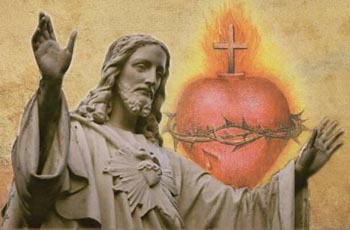 The Sacred Heart of Jesus |
Clearly, should he have taken this course, the devotion to the Sacred Heart would have spread throughout the whole world. There would have been a good reception in France for the preaching of St. Louis Grignion de Montfort – who also lived at that time. Consequently, his preaching would have extended throughout the whole world and, thereby, the French Revolution could have been avoided.
By means of this request made to the King, the Revolution – in the form it had at the time of St. Margaret Mary – would have been halted, and that evil form which it took later - the French Revolution - would have been prevented.
Therefore, this devotion, from its first movement, from its first indication on the part of the Sacred Heart, has a clearly counter-revolutionary meaning.
Objections to this devotion
In a careful study of this devotion, Professor Fernando Furquim calls attention to the fact that the various counter-revolutionary movements that rose up in the 18th and 19th centuries were linked to the Sacred Heart of Jesus. For example, the French counter-revolutionaries of the Vendée, the Chouans, wore a badge of the Sacred Heart. This devotion invariably has been taken up by the good, inspiring and encouraging them, just as it has been hated by the bad.
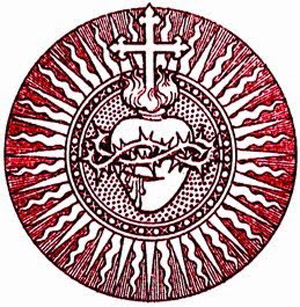 It is perfectly correct to have devotion to a specific organ of Christ |
Then, they go on to say, “This is a sentimental devotion. The heart is the symbol of emotion for the sentimental. So it is a sentimental devotion lacking any theological content and should not be allowed."
A devotion promoted by the Church
In fact, in many solemn, substantial and magnificent papal documents, the Holy See recommended this devotion, e.g., the Encyclical Inscrutabile Divinae Sapientiae of Pope Pius VI in 1775. The Holy See granted many indulgences for those receiving Communion on the First Fridays in reparation for the offenses made against the Sacred Heart. It also showered indulgences on the fraternities and archconfraternities it established in support of the Sacred Heart devotion.
Further, it approved and encouraged the building of churches, altars and statues in honor of the Sacred Heart. The Church, therefore, has approved this devotion superabundantly and it thus has every reason to deserve our trust.
As for the argument that you cannot have a devotion to each part of the Sacred Body of Our Lord, this is without any merit. In fact, in our private devotions, we can adore Our Lord in His Sacred Hands; we can and we should adore Him in His infinitely expressive, eloquent, regal, instructive and saving Eyes. One need only recall that it was a glance of Our Lord that moved St. Peter to repent for his triple denial in order to realize that to adore Our Lord in his divine Eyes is certainly something one can do.
But the Church, who has a strong sense of the ridiculous and understands that the ridiculous can be one step away from the sublime, understands that vulgar minds are always quick to employ sarcasm to degrade devotions like these to a part of the body, which really can shock human sensitivities. But such devotions are not against reason, and can most appropriately be made.
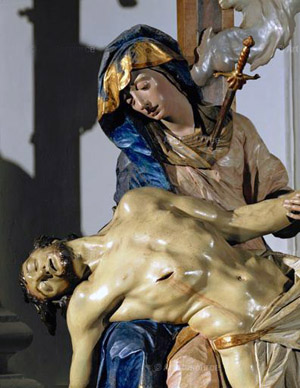 Our Lady adored the body of her beloved Son |
A beautiful way to worship Our Lord Jesus Christ is to unite ourselves to the thoughts and meditations of Our Lady when Our Lord was taken down from the Cross, when she held His Sacred and blood-drained Body in her lap. She contemplated the part of that macerated Body with boundless love, veneration, respect and affection. She considered the members and adored them in their significance and function. She measured the offense against His divinity in having those parts flagellated. With this, in short, she practiced this devotion, adoring different parts of her Divine Son’s Body.
Therefore, it is only for a question of convenience, a sense of appearances and proportion, so to speak, that keeps the Church from promoting the adoration of many of the parts of the Body of Our Lord.
What is devotion to the Sacred Heart?
What exactly is devotion to the Sacred Heart? It is the devotion to the organ of Our Lord that is the Heart. But in Scripture, the heart does not have the sentimental meaning it took on at around the end of the 18th century, and certainly in the 19th century. The heart does not express sentiment.
When Scripture says: "With my whole heart have I sought thee,” (Ps 119:10) the heart here is the human will, the human purpose, properly said, human holiness. Thus, when the Prophet says this, he means, "With my whole will I have sought thee.” The Gospel also says: "Our Lady kept all these words, pondering them in her heart.” (Luke 2:19) You can see that it is not a sentimental heart spoken of here, but her will, her soul, that guarded these things and thought about them.
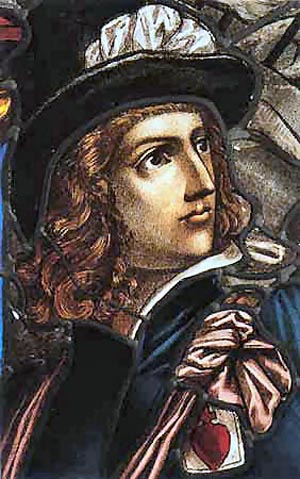 |
By correlation, there is the immensely significant devotion of the Immaculate Heart of Mary. The Immaculate Heart of Mary is a shrine inside which we find the Sacred Heart of Jesus.
Our Lord promised an outpouring of grace for this devotion. The Sacred Heart made special promises to those who make the nine First Fridays. The most striking of them, perhaps, is that those who make the Nine First Fridays will not die without the grace of final repentance. This is not to say that they will certainly go to Heaven. It is to say that they will have a great grace before they die, so great that every hope can be had for their salvation.
You understand how diligently the Church has strived in the past for this devotion to be known, appreciated and understood by our reason without sentimentalism. A manly devotion seeks the reason for a thing and then loves that thing for its reason of being. It is in this way that the strong man and strong woman of the Gospel judge pious things.
Therefore, we should ponder this devotion and turn our souls, our wills, to the Heart of Jesus as the source of those graces Divine Providence planned to give men in the epoch of the Revolution. It is a means of grace intended for the difficult times to come, these very times in which we live today.
We should ask the Heart of Jesus, through the blood and water that flowed from It, to cleanse and restore us. This is my suggestion when you meditate and pray on Fridays, and especially on the first Friday of the month and the Friday of Passion Week.
I close, reminding you of that soldier who pierced the Heart of Jesus with a spear. Upon making this act of violence against the Sacred Heart of Jesus, the water and the blood poured from the side of Our Lord and spilled onto his eyes. Then, the eyes of the soldier, who was becoming blind, were immediately healed and he regained his sight. For us, this is most eloquent and significant.
It means that those who have devotion to the Sacred Heart of Jesus may ask for similar graces, not necessarily the physical miracle, but rather a grace for our souls. If we want to have the Catholic sense, a counter-revolutionary understanding of things, if we want to perceive how the Revolution and Counter-Revolution are working around us and in us, if we want to know our defects, to understand the souls of others to do good for them, to have keen insight in our studies, to have a good psychological equilibrium and be cured of nervous problems of all types, then we can and we must have recourse to the Sacred Heart of Jesus.
We should ask for a grace pouring from His Sacred Heart – like the blood and water that cured the soldier – that will eradicate the total or partial blindness of our souls. Let us pray, then, to the Sacred Heart of Jesus through the Immaculate Heart of Mary, for this is the only way we will obtain the graces to cure us from our multiple blindnesses. Doing this, we will make a splendid request and be on the road to obtaining a magnificent grace.
Combativity & Restoration of Christendom
Atila S. Guimarães & Marian T. Horvat
The bond of friendship between Eternal Wisdom and man is so close as to be incomprehensible, St. Louis de Montfort tells us. From the moment when Divine Wisdom assumed a human nature and died to redeem man, he “is loved by Divine Wisdom as a brother, a friend, a disciple, a pupil. Man is the price of His blood, and the co-heir to His kingdom.” (1)
 |
Paradoxically, Our Lord decided to give an eternal supreme and loving intimacy with Him not when all of society was ordered to His Law in the Middle Ages, but at a time in history when the heart of man, influenced by rationalism and the Cartesian world view, was becoming cold and distant.
In the mid-17th Century, Our Lord appeared to a simple 24-year-old nun of the Order of the Visitation of Our Lady at Paray-le-Monial. “Behold this Heart which has so much loved men,” He said, and through St. Margaret Mary Alacoque, He invited the whole world to return to this divine intimacy and friendship by means of devotion to His Sacred Heart.
It is a message of mercy and love. But it is much more. At this moment in history, it is interesting to look more closely at the invitations of the Sacred Heart to man. For in this message, there is a whole world-view of history, a reiteration of the social teachings of the Church, a call to Catholic Militancy, a rejection of Jansenism, an affirmation of the goodness of abundance and coherence of superfluity, and an invitation to become the Apostles of the Latter Times.
Plan of devotion to the Heart of Jesus in the course of History
Adam, king of creation, made of the “slime of the earth and having received the breath of life from God,” was a worthy image and likeness of the Creator. (Gen. 2:7) So that he might have a companion in the earthly paradise, God gave him a spouse. God communicated to Adam a mysterious deep sleep, and while Adam slept He took one of the ribs near his heart, and made Eve. (Gen. 2:21-22).
Therefore, while man proceeds from the slime of the earth, the woman proceeds in a certain way from the heart of man. If the first was created outside of Paradise and was introduced as a privilege into it, the second, Eve, was born within Paradise, having as prime matter that which the man had of the most noble, something near his very heart. This is why woman is more refined and fragile than man. And man, made outside of Paradise, is rougher, and stronger by nature.
If Adam had governed Creation according to the plan of God, Eve would have been his companion in intimacy and given him repose. From this, one can understand the affirmation of St. Paul (so hated and misunderstood by feminists) that man “is the image and glory of God; but the woman is the glory of the man. For the man is not of the woman, but the woman of the man.” (1.Cor. 11:7-8) Such was the first draft of the plan God had for the first couple, and then, for all humanity.
After man sinned, this plan was upset. From king and queen of all creation, the two in many ways became subject to the earth: “With labor and toil shalt thou eat thereof all the days of thy life.” Man was sentenced to earn his bread by the sweat of his brow, and woman to bring forth children in sorrow. (Gen. 3:16-19) These were the sentences of punishment that Adam and Eve brought on themselves and all their progeny. No longer the glory of the friendship of God, the reign over a docile and obedient paradise, but a hostile creation turned against man, and within himself an obscuring of the light of grace, the clouding of the intelligence, the revolt of the will, and the unleashing of the sensibilities. This was the punishment for the disobedience of man to God. In short, the regency of grace over nature and the easy predominance of the spirit over matter were lost.
Our Lord Jesus Christ came to redeem this sin and to alleviate suffering. In a second metaphorical “deep sleep,” in the mysterious sleep of the Cross, God took from the open Heart of the Second Adam that perfect Spouse - the Church, which would be for Him the concentration of all His refinements, the joy of His intimacy, and the perfect companion for His repose: His glory on this earth. From the Sacred Side of Christ, the Holy Catholic Church, Mystical Spouse of the Savior would be born. The water and blood flowing from His Sacred Heart would wash the eyes of sinners, open the minds of men to divine light and, falling to the ground, baptize the earth that until then was in the possession of the “prince of this world”. This blood and this water would give origin to a river, the river of sacraments from which all graces come. This regenerated earth would permit man to return to that initial plan of God, and even surpass it.
The History of the Redemption is the story of the difficulty of man in conquering the consequences of sin and adapting himself to the desires of God. Even in face of the weakness of man, the Second Adam did not abandon the men He came to save. Seeing their vacillation, their inconstancy, their ingratitude, He offered a solution for this weakness, a stimulus for the fight. He came to open to the world a new and surprising door to perfection. As Divine Wisdom became Man in order to draw the hearts of men to love and imitate Him, He now came to bring His Sacred Heart to men. And His Heart which, in the beginning of the History of Redemption, formed the Mystical Spouse of Christ, now, in the latter times, comes to give it relief, to prepare for the apogee and glorification of the Church.
The Heart of Jesus: an aristocratic devotion
aiming for the restoration of Christendom
In the revelations of Our Lord to St. Margaret Mary Alacoque (1647-1690), there are clear requests that devotion to His Sacred Heart should begin with King Louis XIV and the French court, and from there extend to the rest of the kingdoms of Christendom and the whole world. In a letter from the Saint to her Superior in 1689 she stated that the Sacred Heart had “even greater designs” than the first design of being praised and known by individual souls. She wrote:
“He desires, then, it seems to me,” she wrote, “to enter with pomp and magnificence into the palaces of Kings and Princes, therein to be honored as much as He has been despised, humiliated and outraged in His Passion.” (2)
She said that Our Lord wanted to receive “the consecration and homage of the King and his whole court”. It was over the heart of the King himself that the Sacred Heart desired to triumph, and then, “by his mediation over those of the great ones of the world”. (3)
It is hard to imagine a more efficacious plan to spread devotion to the Heart of Jesus throughout the world. The brilliance of the kingdom and person of Louis XIV (1638-1715) were at its apogee. Few epochs in history have seen a personality so strong and penetrating as that of the Sun King, whose rays and influence penetrated every court in Europe. Politically speaking, Louis XIV shone in no extraordinary way. But in the social and cultural realms, this King marked his century as no other.
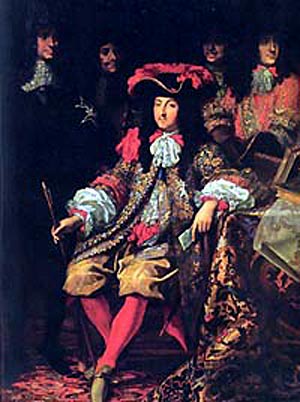 |
Our Lord could not have designed and chosen a more brilliant and efficient instrument in the secular sphere to spread devotion to His Sacred Heart than to ask the King of France to help make it grow and expand throughout the world. Our Lord desired in this way to move the kingdom of France, and then, “all the great men of the earth” so that He might be adored “in the palaces of the Princes and the Kings.” This was, therefore, the desire for a devotion that would permeate the most royal and aristocratic ambiences as well as the humblest of peasant households. Thus would it spread through the whole social body.
This is a principle that seems to be forgotten in our egalitarian age. So often devotion to the Sacred Heart, when it is permitted or fostered, is only encouraged for individuals or families. There is a real and sincere devotion that has developed around the Promises made to individuals who make the reparatory communions on the First Fridays and who make the solemn enthronement of the Sacred Heart in family homes. But this is still not the ideal requested by Our Lord Jesus Christ, who as Master of the parts of the social body, i.e. individuals, families, and even institutions, must evidently also be Master of the whole human society.
All nations, too, are the work of God and belong to Him, and hence Christ is their Master, Lord and King. The Heart of Jesus wants to reign in the very heart of nations, and in the first place those who rule and represent them, who should recognize this dominion and submit to it. This submission should be more from love than from a sense of duty, not so much because Christ has a right to demand it from rulers, as because they desire to submit to His love.
The cry of Our Lord to St. Margaret Mary “Behold this Heart which has so loved men that It spared nothing, even going so far as to exhaust and consume Itself to prove to them Its love” is a call of conversion not only to men or families, but also to nations. In a certain way, it was the restoration of Christendom that was being placed within the reach of the King and nobility of France. The plan of Our Lord was to touch all nations and all social classes, beginning with France, First Daughter of the Church. Thus would the Sacred Heart be the cornerstone of a new Christendom.
The Sacred Heart and the armed fight in defense of the Faith
The Sacred Heart revealed to Saint Margaret Mary Alacoque that He wanted His Sacred Heart “to reign in the King’s palace, to be painted on his standards and engraved on his arms, in order to render him victorious over all his enemies”. (5) In a later letter to her Mother Superior, Sister Margaret Mary revealed that the Divine Heart wished “to be the protector and defender of his sacred person [Louis XIV] against all his enemies visible and invisible. By means of this devotion He wants to defend him and make his salvation sure. … He will make all his undertakings redound to His glory by granting happy success to his armies.”
Our Lord did not hesitate to ask that the symbol of His great love for man be painted on the arms of Catholic warriors. This is quite different from a number of today’s ecumenical ecclesiastics who never tire of asking pardon of the enemies of the Church for the use of Catholic arms in defense of the Faith. How would they explain that Our Lord even went so far as to guarantee His participation in the battles that the King of France should wage in the religious wars of the epoch and to request that His Heart be painted on the arms themselves? He promised victory to those Catholic warriors, offering His Heart as a support like a General who brings his troops an invincible new strategic weapon.
Unfortunately, Louis XIV did not attend to the requests of Our Lord. Yet others did. These were the chouans, those glorious peasants of the Vendée and Bretagne who rose up against the French Revolution in 1793 to fight for the restoration of the Monarchy. On their arms they painted the Sacred Heart of Jesus and on their bodies they bore the badge of the Sacred Heart, popularized by St. John Eudes. Likewise, the Carlists with their red berets and battle cry of “Viva Christo Rey” in the Spanish Civil War of the 1930s put the emblem of the Sacred Heart on their rifles, revolvers, heavy arms and even their tanks.
Perhaps one of the most moving examples of how Our Lord desired to work though one man to win a nation to His Loving Heart is the case of Gabriel Garcia Moreno, the President of Ecuador martyred by the Freemasons in 1875 outside the cathedral where he had just received First Friday Communion. Two years before this, the President of this Republic made a public consecration of Ecuador to the Sacred Heart of Jesus and enacted a law unique in national lawmaking:
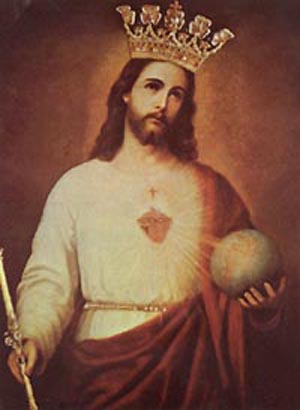 |
“Art. 2: The Feast of that same Sacred Heart of Jesus is prescribed as a civil first-class holyday, to be observed in every cathedral of this Republic by diocesan prelates with all possible ceremony.”
The dying words of this magnificent Catholic statesman were “Courage! God never dies!” (6)
There is a tendency in our days to emphasize the goodness, gentleness and pity of the Magnificent Heart of Jesus, Who is certainly moved by the weakness and distress of those whom He loves. But the good shepherd is also a hero and a warrior; and His love is essentially a contending kind of love. The Heart of Christ longs to win a battle. As He said in the Gospel, He did not come to bring peace to the earth, but the sword.
How admirable is this command of Our Lord to have His Sacred Heart painted on the French standards. It is noteworthy that in this epoch the use of national flags was not yet the general custom. But from the earliest ages, France had always had a sacred standard with the three fleurs-de-lis, one that rested in the sanctuary of St. Denis and was brought out in hours of danger or holy war. It symbolized the Catholic soul of France, and floated like a sacred prayer amid the nation’s banners.
According to a beautiful tradition, before a crucial battle against the fierce Allemani in 496, King Clovis of the Franks called on the “God of Clotilda”. (St. Clotilda, his spouse, a Burgundian princess instrumental in his conversion.) He begged protection for the battle ahead and if he won, he promised to convert to the Catholic Faith. During a very difficult moment of the combat, the symbol of the King of Franks, a banner with three frogs, miraculously changed into another with the three fleurs-de-lis. From this time forward the fleur-de-lis was the principle symbol of the Kings of France.
It is interesting to imagine the fortuitous results of the addition of the Sacred Heart to the delicate three fleurs-de-lis. The French, certainly lacking in neither good taste nor a refined sense of aesthetics would have been naturally disposed to take this command of Our Lord and render the most magnificent expressions of the Catholic spirit. Unhappily, this is not what happened. The words of St. Margaret Mary in 1689 were not heeded, and one century later the storm rose that swept away the French monarchies and, with it, other monarchies.
The Sacred Heart and the glorification of the superfluous
In the religious ambience of the times when Our Lord chose to make His revelations to St. Margaret Mary Alacoque in the mid-17th Century, the influence of Jansenism was strong in the religious and intellectual milieus. Adepts of Jansenism emphasized God’s justice and severity with little emphasis on His willingness to forgive or His divine mercy.
The Jansenist doctrine was born from a spirit of pride and self-sufficiency. It suggested man could not receive anything from God without having first merited it morally or intellectually. It was an attempt to harness the infinite largesse of God to the small confines of justice and reciprocity within the finite limits of the understanding of man.
Our Lord gave the gift of His Sacred Heart to the world to counter this harsh and puritanical spirit that has survived even to our days. In the Sacred Heart of Jesus man finds pardon for the past, peace for the present, hope for the future. The mercy of this Heart, the fountain of all living waters, is so superabundant that even in what seems to be the most irreversible and hopeless moral situations, man can find in this devotion a possibility of pardon and a full return to the life of grace and peace.
Thus Our Lord wanted mankind to know His surplus of mercy, a kind of luxury that surpasses the common economy of grace. A spirit infected with socialist tendencies could see in this excess of mercy a dissipation or excess, if not an injustice. It is the same type of objection he would have in face of the superfluous, the magnificent, and the marvelous in secular society. Looking at a magnificent castle, an outward and visible sign of grandeur and transcendency, he could only react with indignation: “But this is a waste. It is an injustice for such a building to exist when there are hungry people in miserable huts.” Such objections are easy to answer for the man with a Catholic and hierarchical spirit.
In Christ was the plentitude of grace: “And of His fullness we have all received, and grace for grace.” (John 1:16) He merited all graces for us, and the graces through which our souls are sanctified come to us through and flow from the fullness of the grace of Christ. Our Lord, so extraordinarily rich and so desirous of the salvation of man, has permitted His munificence to shine in the multitude of devotions, prayers, pomp and ceremony of His Church. He desired to establish this devotion to the Sacred Heart as a further benefice and aid for man to achieve salvation. It is a manifestation of superabundance, superabundance quite fitting to His Nature. Thus could devotion to His Sacred Heart be interpreted as a legitimation and even the glorification of the superfluous.
The Sacred Heart and the Apostles of the Last Times:
Unlimited confidence and unbounded desires
St. John, the beloved apostle of the Heart of Jesus, appeared in the 13th century to an early devotee of the Sacred Heart, St. Gertrude the Great. He invited her to repose her head alongside his own on the Heart of Jesus. “Why did you speak so little of the loving secrets of the Heart of Jesus?” She asked him. He answered: “My ministry in those early times of the Church was confined to speaking of the Divine Word, the eternal Son of the Father, some words of deep meaning upon which human intelligence might meditate forever, without ever exhausting their riches. But to these latter times was reserved the grace of hearing the eloquent voice of the Heart of Jesus. At this voice, the time-worn world will renew its youth, be roused from its lethargy and again be inflamed with the warmth of Divine love.”
The key to the Sacred Heart was given by Our Lord to St. Gertrude: that all can be won with unlimited confidence and unbounded desires. She understood that confidence is the key that opens the treasures of the infinite mercy of God. To her confidence alone, she attributed all the gifts she received. Our Lord Himself told her: “Confidence alone easily obtains all things.” Once when St. Gertrude was troubled with temptation, she implored divine assistance. Our Lord comforted her with these words:
“Anyone suffering from human temptations, who flees to My protection with firm confidence, belongs to those of whom I can say: ‘One is My dove, My chosen one out of thousands, who has pierced My Heart with one glance of her eyes.’ And this confidence wounds My Heart so deeply that were I unable to relieve such a soul, it would cause my heart a sadness which all the joys of Heaven could not assuage … Confidence is the arrow which pierces My Heart, and does such violence to My love that I can never abandon her.”
Hand in hand with confidence Our Lord desires that we become men and women of great desire - an unlimited desire for the glory of the Sacred Heart of Jesus and Mary. St. Gertrude taught the great secret for our times: that Our Lord “accepts the will for the deed”. “The goodwill in undertaking a work to fulfill My desire, notwithstanding the difficulty met with, is most agreeable to Me, and I accept the goodwill for the deed. Even if he be unable to succeed, I will reward him as if he had accomplished it,” Our Lord revealed to her.
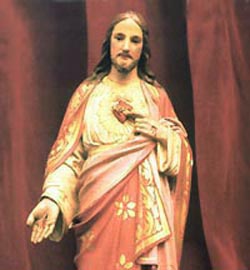 |
Another devotee of the Sacred Heart, the great St. Catherine of Siena, spoke these prophetic words, perhaps in anticipation of our very days: “O my God, how wilt Thou be able in these unhappy times to provide for the wants of Thy Church? I know what Thou wilt do. Thy love will raise up men of desires. Their finite works joined to infinite desires, will make Thee hear their prayers for the salvation of the world.”
The graces that were shed over the Church and the world in the 17th Century with the apparitions of Our Lord to St. Margaret Mary Alacoque to spread devotion to the Sacred Heart established a new intimacy between men and Jesus Christ, whose delight is more to be with the sons of men than to rule the Seraphim. This new economy of grace certainly sought to make possible a profound - and easy - intimacy with Our Lord. A love for God until then unknown brings as its consequence a combativity until then unknown against the enemies of the Church of Christ. It is an indispensable reciprocal relationship.
Thus has this devotion been given to the Church to help to form those indomitable warriors who will come to confront the Anti-Christ and his followers. These will be the Apostles of the last times, described by St. Louis Grignion de Montfort:
“In a word, we know that they shall be true disciples of Jesus Christ, walking in the His footsteps of poverty, humility, contempt of the world, charity, teaching the narrow way of God in pure truth, according to the holy Gospel, and not according to the maxims of the world; removed from any human concerns, without attachment to anyone; sparing, fearing and listening to no mortal, however influential he may be. They shall have in their mouths the two-edged sword of the Word of God. They shall display on their shoulders the bloody standard of the Cross, the Crucifix in their right hand and the Rosary in their left, the sacred Names of Jesus and Mary in their Hearts, and the modesty and mortification of Jesus Christ in their own behavior.
“These are the great men who are to come; but Mary is the one who, by order of the Most high shall fashion them for the purpose of extending His empire over that of the impious, the idolaters and the Muslims. But when and how shall this be? God alone knows.”
The Sacred Heart of Jesus wants to inspire the hearts of men of our days with a great combativity and a great desire to accomplish the deeds of which it can seem we are not even capable. These will be the sons and daughters of Blessed Mary: it was from Her Immaculate Heart that Christ drew His humanity. His Heart began its first beating within the chaste precincts of Mary’s virginal womb. No human heart will ever be more closely attuned to the Heart of the God-Man than was, and is, that of His Mother. And just as the prayers and desires of Mary hastened the coming of Our Lord, so the prayers and desires of the just, in shortening the days of tribulation, will hasten the triumph of the Church.
1. St. Louis de Montfort, The Love of Eternal Wisdom (Bayshore, NY: Montfort Publications,1960), p. 31.
2. Emile Bougard, The Life of St. Margaret Mary Alacoque (Rockford: TAN, 1990), p. 268.
3. Ibid., p. 269
4. Nancy Mitford, The Sun King (New York: Crescent Books, 1966), p. 32.
5. Bougard, The Life of St. Margaret Mary, p. 269.
6. Arthur R. McGratty, S.J., The Sacred Heart: Yesterday and Today, NY: Benzinger Bros., 1951, pp. 202-3
